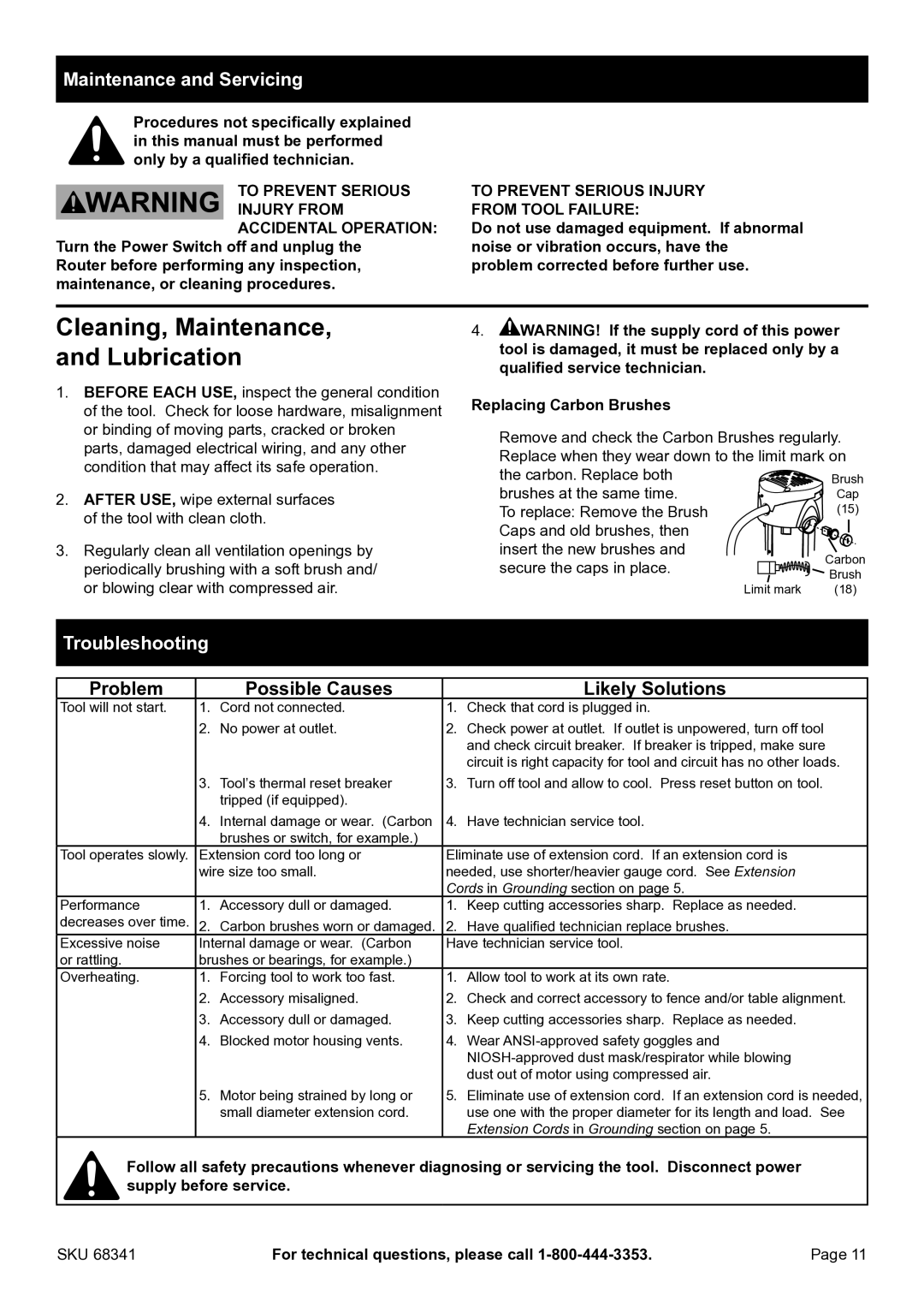
Maintenance and Servicing
Procedures not specifically explained in this manual must be performed only by a qualified technician.
|
| To prevent serious | To prevent serious injury |
|
| |||
|
|
|
| |||||
|
| injury from | from tool failure: |
|
| |||
|
| accidental operation: | Do not use damaged equipment. If abnormal |
|
| |||
Turn the Power Switch off and unplug the | noise or vibration occurs, have the |
|
| |||||
Router before performing any inspection, | problem corrected before further use. |
|
| |||||
maintenance, or cleaning procedures. |
|
|
|
|
|
| ||
|
|
| ||||||
Cleaning, Maintenance, | 4. | WARNING! If the supply cord of this power | ||||||
and Lubrication |
| tool is damaged, it must be replaced only by a | ||||||
| qualified service technician. |
|
| |||||
1. BEFORE EACH USE, inspect the general condition | Replacing Carbon Brushes |
|
| |||||
of the tool. Check for loose hardware, misalignment |
|
| ||||||
or binding of moving parts, cracked or broken |
| Remove and check the Carbon Brushes regularly. | ||||||
parts, damaged electrical wiring, and any other |
| |||||||
| Replace when they wear down to the limit mark on | |||||||
condition that may affect its safe operation. |
| |||||||
| the carbon. Replace both | Brush | ||||||
|
|
|
| |||||
2. After Use, wipe external surfaces |
| brushes at the same time. | Cap | |||||
| To replace: Remove the Brush | (15) | ||||||
of the tool with clean cloth. |
| |||||||
| Caps and old brushes, then |
|
| |||||
|
|
|
|
|
| |||
3. Regularly clean all ventilation openings by |
| insert the new brushes and | Carbon | |||||
periodically brushing with a soft brush and/ |
| secure the caps in place. |
|
| ||||
|
|
| Brush | |||||
|
| |||||||
or blowing clear with compressed air. |
| Limit mark | (18) | |||||
|
|
|
|
|
|
|
| |
Troubleshooting |
|
|
|
|
|
|
| |
|
|
|
|
|
|
| ||
|
|
|
|
|
|
| ||
Problem |
| Possible Causes |
| Likely Solutions |
|
| ||
Tool will not start. | 1. | Cord not connected. | 1. Check that cord is plugged in. |
|
| |||
| 2. | No power at outlet. | 2. | Check power at outlet. If outlet is unpowered, turn off tool |
|
|
|
| and check circuit breaker. If breaker is tripped, make sure |
|
|
|
| circuit is right capacity for tool and circuit has no other loads. |
| 3. | Tool’s thermal reset breaker | 3. | Turn off tool and allow to cool. Press reset button on tool. |
|
| tripped (if equipped). |
|
|
| 4. | Internal damage or wear. (Carbon | 4. | Have technician service tool. |
|
| brushes or switch, for example.) |
|
|
Tool operates slowly. | Extension cord too long or | Eliminate use of extension cord. If an extension cord is | ||
| wire size too small. | needed, use shorter/heavier gauge cord. See Extension | ||
|
|
| Cords in Grounding section on page 5. | |
Performance | 1. | Accessory dull or damaged. | 1. | Keep cutting accessories sharp. Replace as needed. |
decreases over time. | 2. | Carbon brushes worn or damaged. | 2. | Have qualified technician replace brushes. |
Excessive noise | Internal damage or wear. (Carbon | Have technician service tool. | ||
or rattling. | brushes or bearings, for example.) |
|
| |
Overheating. | 1. | Forcing tool to work too fast. | 1. | Allow tool to work at its own rate. |
| 2. | Accessory misaligned. | 2. | Check and correct accessory to fence and/or table alignment. |
| 3. | Accessory dull or damaged. | 3. | Keep cutting accessories sharp. Replace as needed. |
| 4. | Blocked motor housing vents. | 4. | Wear |
|
|
|
| NIOSH‑approved dust mask/respirator while blowing |
|
|
|
| dust out of motor using compressed air. |
| 5. | Motor being strained by long or | 5. | Eliminate use of extension cord. If an extension cord is needed, |
|
| small diameter extension cord. |
| use one with the proper diameter for its length and load. See |
|
|
|
| Extension Cords in Grounding section on page 5. |
Follow all safety precautions whenever diagnosing or servicing the tool. Disconnect power supply before service.
SKU 68341 | For technical questions, please call | Page 11 |
